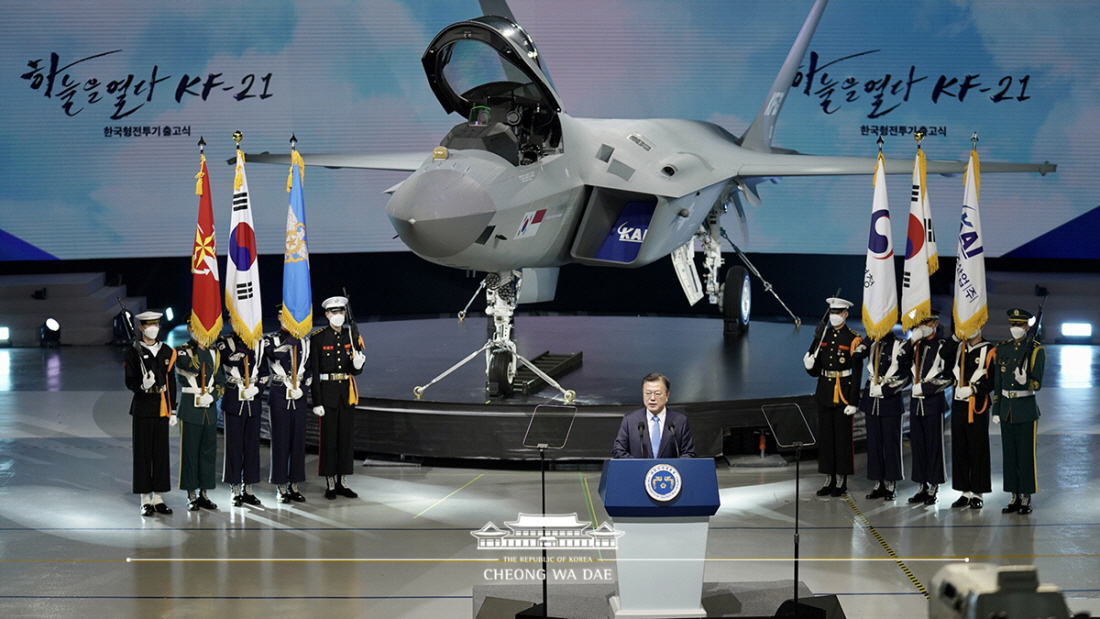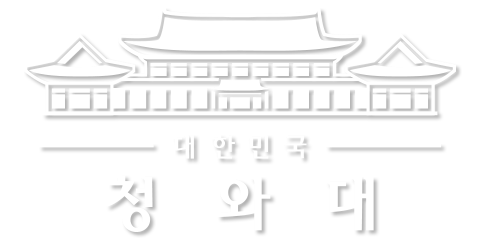이 웹사이트는 제19대 대통령 임기 종료에 따라 대통령기록관이 「대통령기록물 관리에 관한 법률」에 의해 이관받아 서비스하는 대통령기록물입니다. 자료의 열람만 가능하며 수정 · 추가 · 삭제는 불가능합니다.
다만, 「개인정보보호법」에 의하여 개인의 정보를 보호받기 원하시는 분은 관련 내용(요청자, 요청내용, 연락처, 글위치)을 대통령 웹기록물 담당자(044-211-2253)에게 요청해 주시면 신속히 검토하여 조치해 드리겠습니다. 감사합니다.
SPEECHES & REMARKS
BRIEFINGS

Fellow Koreans, relevant military personnel and aviation industry professionals, distinguished guests from home and abroad,
Today is a special day. The commanding presence of the “KF-21” – the prototype of the next-generation, independently developed Korean fighter jet – has finally been unveiled. We have built this cutting-edge combat aircraft with our own technology. Following ground and flight tests, full-fledged mass production will begin. We intend to deploy 40 KF-21s by 2028 and 120 in total by 2032.
We, too, have now come to possess an advanced supersonic fighter jet manufactured with indigenous technologies. Korea has become only the eighth nation in the world to achieve this feat. A new era of self-reliant national defense has begun. We have set a historic milestone in aviation industry development. This accomplishment has been made possible thanks to the efforts of the entire development team from the private, public and military sectors and participating businesses as well as support from the people. With an immense sense of pride, I extend my gratitude and respect.
In particular, my appreciation goes to the Indonesian Government that has partnered with the Republic of Korea for joint development, confident in our potential. Indonesian President Joko Widodo sent a congratulatory video message for today’s rollout ceremony. Indonesian Defense Minister Prabowo Subianto and his delegation are here in person. I wholeheartedly welcome our friends. Our two countries will continue to work together until we can market the fighter jointly in third countries after development is completed and mass production begins.
Fellow Koreans,
The name “KF-21” reflects our determination to defend our skies on our own in the 21st century. Our people chose to name this fighter jet “Boramae” (Fighting Hawk) after the symbol of our Air Force.
The KF-21 Boramae will become our Air Force’s backbone. Capable of flying at approximately 1.8 times the speed of sound and carrying 7.7 tons of ordnance, it has all-weather maneuvering and combat capabilities. It can carry out a variety of operations – not only engaging in dogfights but also neutralizing infiltrations over land or sea and making long-range strikes on enemy air defenses.
The KF-21 Boramae also has excellent response capabilities for increasingly important electronic warfare. Its “AESA radar” and “Infrared Search and Track System” can quickly detect enemy aircraft and missiles. Its “Electro Optical Targeting Pod” can precisely zero in on ground targets. It is also equipped with state-of-the-art avionics developed with homegrown technology, including “Integrated Electronic Warfare Equipment” to disrupt enemy radar.
The advantages of domestically manufactured fighter jets are beyond description. We can produce and deploy them whenever needed. Their parts can be replaced and repaired at any given time. The AESA radar and other cutting-edge avionic technology acquired in the process of development can be used to upgrade such existing fighter jets as the KF-16 and F-15K.
Our drone forces, currently deployed primarily for surveillance and reconnaissance missions, will become sophisticated enough by 2025 to be able to carry out missions as varied as relaying communications and attacking. A satellite constellation system designed to foster independent reconnaissance capabilities will considerably boost the strengthening of our space technology-driven defense power.
Fellow Koreans,
The successful development of a cutting-edge Korean fighter jet will help reinforce self-reliant defense capabilities and bring about tremendous economic effects as well.
The KF-21 consists of over 30,000 individual parts, and more than 65 percent of them have been produced locally. Participating in this localized production are more than 700 Korean businesses, including conglomerates, middle market companies and SMEs. In the process of development alone, some 12,000 decent jobs have been created. The KF-21’s full-fledged mass production will generate 100,000 additional job opportunities and new added value worth 5.9 trillion won. Its vibrant export will further enhance these ripple effects. More than anything else, the technological prowess, workforce and infrastructure accumulated by businesses participating in the KF-21 project will become a driving force that will make the aviation industry an undeniable future growth engine of the Republic of Korea.
The aviation industry requires a cluster of state-of-the-art technologies in various fields. Its entry barrier is very high because no country is willing to transfer proprietary technology. For these reasons, only a handful of the world’s highly developed countries could strategically foster this leading high-value-added, knowledge-based industry of advanced nations. However, once competitiveness is secured, the aviation industry can create stable profits and jobs on a long-term basis.
At last, we have also caught up. From the development of a basic trainer, advanced jet trainer and light attack aircraft to a state-of-the-art fighter jet, we have moved our aviation industry forward along the path of developed countries. In IT and other underlying technology, Korea has global competitiveness as well. The Government has set a goal to steer the country into becoming one of the world’s seven aviation powerhouses in the 2030s. In accordance with the third basic plan for aviation industry development, laid out in March, our self-reliance in fighter jet engines and other key technologies will be enhanced. We will also take a long-term perspective when investing in the development of new innovative technologies such as electric and hydrogen-powered aircraft and urban aviation mobility. Systematic and active support will be provided for our aviation industry, including the development of unmanned aerial vehicles.
Fellow citizens, military personnel and aviation industry professionals, distinguished guests,
A century ago, Ahn Chang-ho – penname Dosan – and other visionaries as well as the Provisional Republic of Korea Government envisioned creating an air force within the Korean Liberation Army. Today, we have achieved the dream of our forebears, “Let us protect our skies with our own hands.” It is truly overwhelming.
In 2001, then-President Kim Dae-jung unveiled the vision of creating a domestically developed advanced fighter jet. It was not until 2010 that its development began in earnest, following as many as seven feasibility studies. As the transfer of key technologies from outside became difficult, there was a lot of skepticism that our technology alone could secure development. However, our developers turned that doubt and anxiety into confidence and the impossible into the possible.
Today, I would like to introduce 20 professionals who have made distinguished contributions to the development of the KF-21, a source of pride for us. Let’s welcome them with a big round of applause.
First, these are the Korea Aerospace Industries employees who have been in charge of designing and producing the KF-21:
Lee Il-u, chief engineer, oversaw development of the KF-21 by drawing upon his experience developing the T-50 advanced jet trainer.
Sohn Yeong-seok, principal researcher, systemized and computerized the design process to enable high-quality work.
Choi Jung-du, chief technologist, ensured the safety of the aircraft through thorough inspection of the procured parts.
Kang min-seong, team leader, analyzed anomalies and thoroughly managed the production process.
Park Seong-han, team leader, developed a flight control system for safe operation.
Kang Byeong-gil, team leader, efficiently placed pieces of equipment through an optimal design.
Ahn Se-yeong, manager, solved production-related problems in step with the development plan.
Bae Mun-Seong, manager, resolved difficulties as the spread of COVID-19 began to delay parts procurement.
Lee Seung-min, senior researcher, improved the aircraft’s performance and quality through data analysis.
Park Hee-eun, researcher, successfully led consultations with foreign companies needed for equipment development.
Next are staff from the Defense Acquisition Program Administration:
Jeon Nam-hee, team leader, took the lead in preparing and carrying out exploratory development and system development.
Jeong Tae-il, deputy director, developed key flight control software and test equipment.
Lee Sang-eun, deputy director, secured technical data in a timely manner from the United States and Europe.
Major Jo Hae-gwang provided input into the design so that the aircraft can be armed in multiple ways.
Next are researchers from the Agency for Defense Development who were involved in the AESA radar development:
Seo Seung-hee, lead researcher, carried out the important mission of overseeing general management of the development of the fighter jet’s eyes, the AESA radar.
Bae Jin, senior researcher, demonstrated prowess by combining the abilities of the excellent researchers during the design of the AESA radar.
Noh Ji-eun, lead researcher, took the lead in developing software algorithms that enable the AESA radar to function properly.
The following are private-sector researchers who led the development of advanced avionics equipment.
Park Gi-yeong, senior researcher from Hanwha Systems, worked hard to develop the Electro Optical Targeting Pod.
Kim Du-hwan, senior researcher from LIG Nex1, contributed to the development of the Integrated Electronic Warfare Equipment.
Kim Min-cheol, senior researcher from Hanwha Systems, played a leading role in the development of the Infrared Search and Tracking System.
Once more, I ask you to give a big round of applause for these 20 developers who made today’s historic rollout of the KF-21 prototype possible.
Without the constant dedication of these developers over the past 20 years,
we might not have come to meet the KF-21 today. The confidence and pride created by the KF-21 will be a source of great strength for the Republic of Korea as it proceeds toward a better future.
Thank you.



